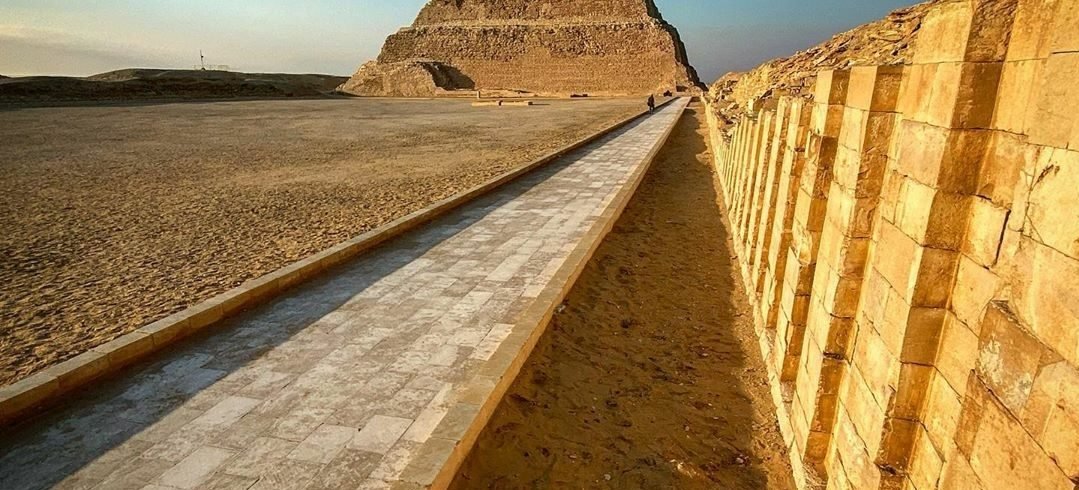Saqqara Step Pyramid Complex
ONLY 15 MILES (24 KM) SOUTHEAST OF CENTRAL CAIRO, Saqqara is one of the richest archaeological Sites in Egypt. in fact, few sites in the world can compare. It is a vast desert necropolis built for the kings and nobles of the Old Kingdom, and amohgits highlights are the very first pyramid, some splendid tomb paintings, end one of the great oddities of Egyptology, the Serapeum, a haunting burial place of mummified sacred bulls
Saqqara was founded as the necropolis, or burial city, for the Old Kingdom capital, Memphis see p. 154). Its earliest tombs date from the 1st dynasty (3100-2890 E11), its latest from the Persian era circa 500 B.C.). However, all this was unknown until a French former schoolteacher named Auguste Mariette (see pp. 80-81) began excavating at Saqqara in 1850. He
discovered a half-buried Sphinx in the sand and remembered a passage from the first-century Greek geographer Strabo that mentioned a Serapeum at Memphis and sphinxes in the sand. Following this lead, Mariette began digging and succeeded in uncovering the avenue of sphinxes and, from that, the Serapeum. His discovery sparked the extensive and continuing
excavation of the site. Much more has been found since then, but archaeologists believe that the monuments seen at Saqqara today represent only a fraction of what might still be buried. Even so, there is more than enough uncovered and open to the public to make a visit to Saqqara a bewildering experience. Three main groupings of monuments should head any visitor’s list, centered on the Step Pyramid, the Pyramid of Teti I, and the Serapeum. You should allow at least half a day to explore them.
THE FIRST PYRAMID
Centerpiece of Saqqara is the Step Pyramid and surrounding enclosure of Djoser (also spelled Zoser), king of Egypt from 2667 to 2648 B.C. It was built for the king by Imhotep, who was both high priest and the world’s first big name in architecture. Though less than half the height of the two largest pyramids at Giza, and much less well known, Imhotep’s monument represents a far greater achievement. Before Saqqara, the building material of choice had been mud brick, and the common building form was the mastaba ( from the Arabic word for “bench”), a simple, rectangular, slab like structure covering a burial pit. Imhotep took the mastaba, constructed it in stone, and added to it five times, one on top of the other, each successive layer being smaller than those below to create a pyramid like effect. The high priest surrounded his king’s pyramid with a host of secondary structures and enclosed them all within a bastioned perimeter wall 32 feet (10 m) high.
Entrance was, as it is today, via a gate in the southeastern corner and along a corridor_ of 40 pillars, their design inspired by bundles of tied reeds. This leads into the Great South Court, an open area the size of soccer field in front of the pyramid. Decoration is sparse, hut in the southwest corner is a building projecting into the court that has a frieze of rearing cobras. This venomous reptile was a symbol of royalty, and it is here to protect the Southern Tomb, sunk deep below, where the king’s ka, or life force, was put to rest in the form of a statue. If you ascend the stairs to the top of the wall you can look down the shaft, but the tomb is closed to visitors.
On the east side of the court is what’s known as the Heb-sed Court, linked to a ritual in whic‘ the king renewed his rule by re enacting his coronation. To the north are the remains of two pavilions, one dedicated to Upper Egypt, the other to Lower, the two kingdoms united under Djoser. In the first of these, protected under clear plastic, is the world’s oldest known example of tourist graffiti (12th century B.C.), in which visitors from Thebes express their admiration for the king and his monuments.
A little farther north, the most intriguing aspect of the complex is usually indicated by a milling crowd of visitors; they are in line to see Djoser himself. Here at the foot of the pyramid’s north face is a stone kiosk, known as a serdab, with a slot through which you look to meet the level stare of the king, enshrined within a life-size, painted statue. This arrangement enabled the king’s ka to communicate with the outside world. The statue is a copy; the original is displayed in the atrium of the Egyptian Museum in Cairo.
South of Djoser’s enclosure, a misshapen mound represents the
the slumped remains of the Pyramid of Unas, resting place of the last king of the 5th dynasty (R. 2375-2345) When the pyramid was entered in 1881, the walls were found to be covered in hieroglyphs, the earliest example of texts found in any ancient Egyptian burial. Unfortunately, because of the damage being caused by visitors, the pyramid is now closed to the public. Its causeway is flanked by a number of well-preserved tombs, and several of these are usually open.
TOMB PAINTINGS Although the writings on the walls of the Pyramid of Unas are off-limits to visitors, similar early “pyramid texts” can be seen in the Pyramid of Teti (first king of the 6th dynasty, R. 2345-2323). These vertical columns of script.

